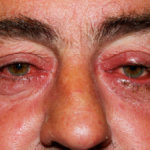
As discussed in an earlier post, one of the most common symptoms of dry eye syndrome is tearing. Even with an explanation of how this occurs, many are unconvinced. How do you know that your doctor isn’t just telling you this to give you pause while he slips out of the exam room and on to his next patient. “Ah, the old dry eye ruse:” tell the patient that having too much tear is really related to having too little tear and disappear through the door while the unsuspecting patient is mulling this over.
Well, as much as the demands of modern medicine do limit that amount of time doctors can spend with their patients (and, BTW, this really is not in the doctors control – topic for another post), the dry eye explanation is not a ruse. Dry eye syndrome is something that can often be objectively diagnosed at the slit lamp (aka biomicroscope) in the eye doctor’s office. Following is a description of how an ophthalmologist would typically diagnose dry eye syndrome.
Assess Symptoms
As with most medical disorders, the diagnosis of dry eye syndrome is 80% listening to the patient. Following are the things I listen for:
What are the symptoms?
- Tearing
- Ocular irritation
- Foreign Body Sensation (a sense that something is in the eye)
- Red eye
- Tired eyes
- Flucturating vision with certain activities
When do the symptoms occur?
- First thing in the morning
- Later in the day
- After extended periods of concentration
- With reading
- With computer use
- With TV use
What medications are currently being used?
- Blood pressure medications
- Diuretics
- Hormone replacement therapy
- Allergy medications
Examine The Eye
Even with the best listening, the diagnosis must be confirmed by examining the eye. Following are the things I look for:
- A decreased tear lake (a thin tear film over the cornea)
- A decreased Tear Breakup Time (the tear film is not stable)
- An irregular corneal surface
- Dry patches on the corneal surface
Test The Tear Film
Sometimes special testing is required to diagnose dry eye syndrome. Following are some common tests for dry eye syndrome:
- Schirmer’s testing: evaluates how much tear is produced in five minutes
- A decreased Tear Breakup Time (the tear film is not stable)
- Lissamine Green staining: reveals devitalized corneal surface cells
- Rose Bengal staining: also reveals devitalized corneal surface cells
- Lactoferrin level test: a low level indicates dry eyes
Not all of the above examination or testing methods are necessary to diagnose dry eye syndrome. However, some combination of the above is used to provide a more objective assessment of the presence or absence of dry eye.
© 2009 David Richardson, MD








Leave a Reply